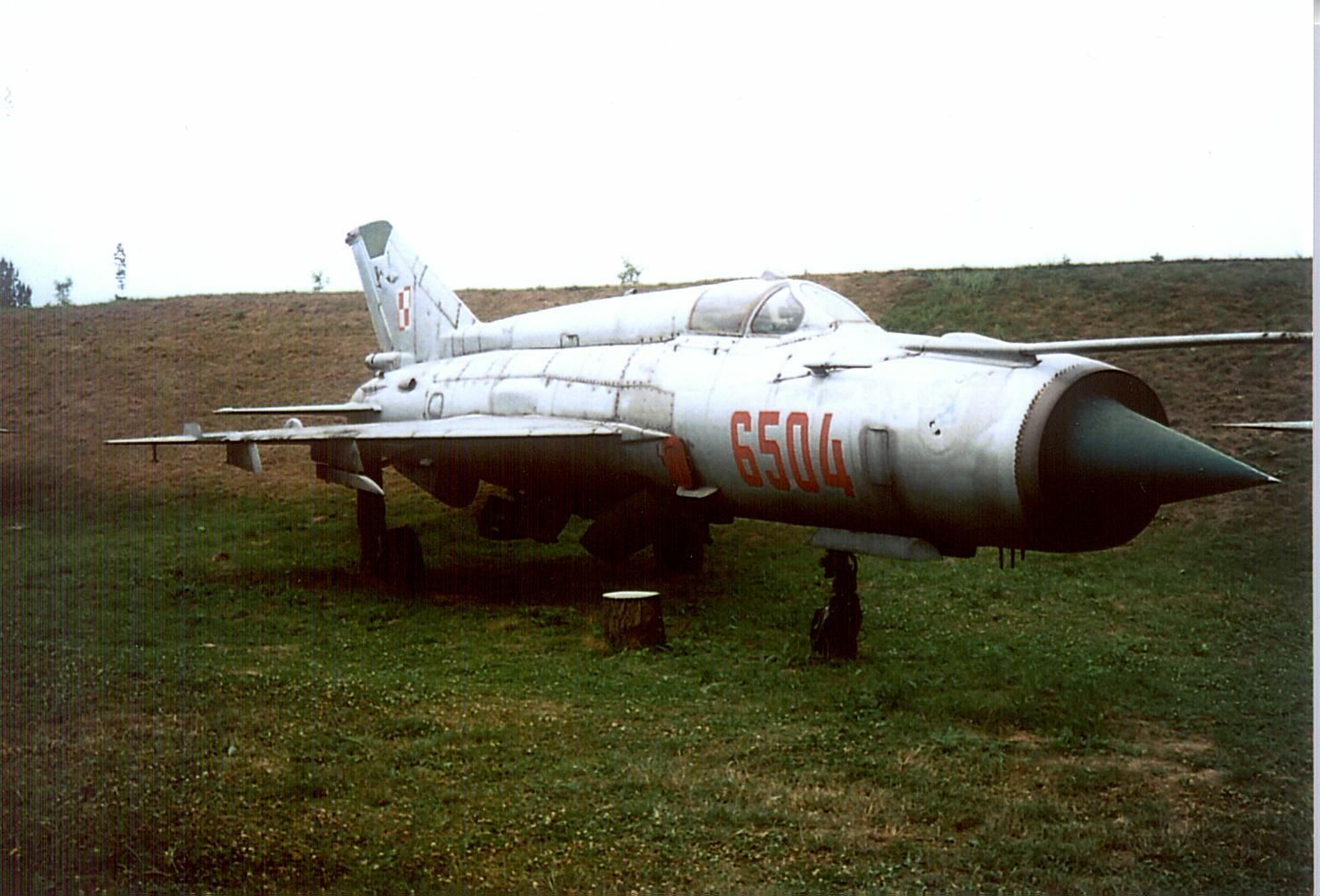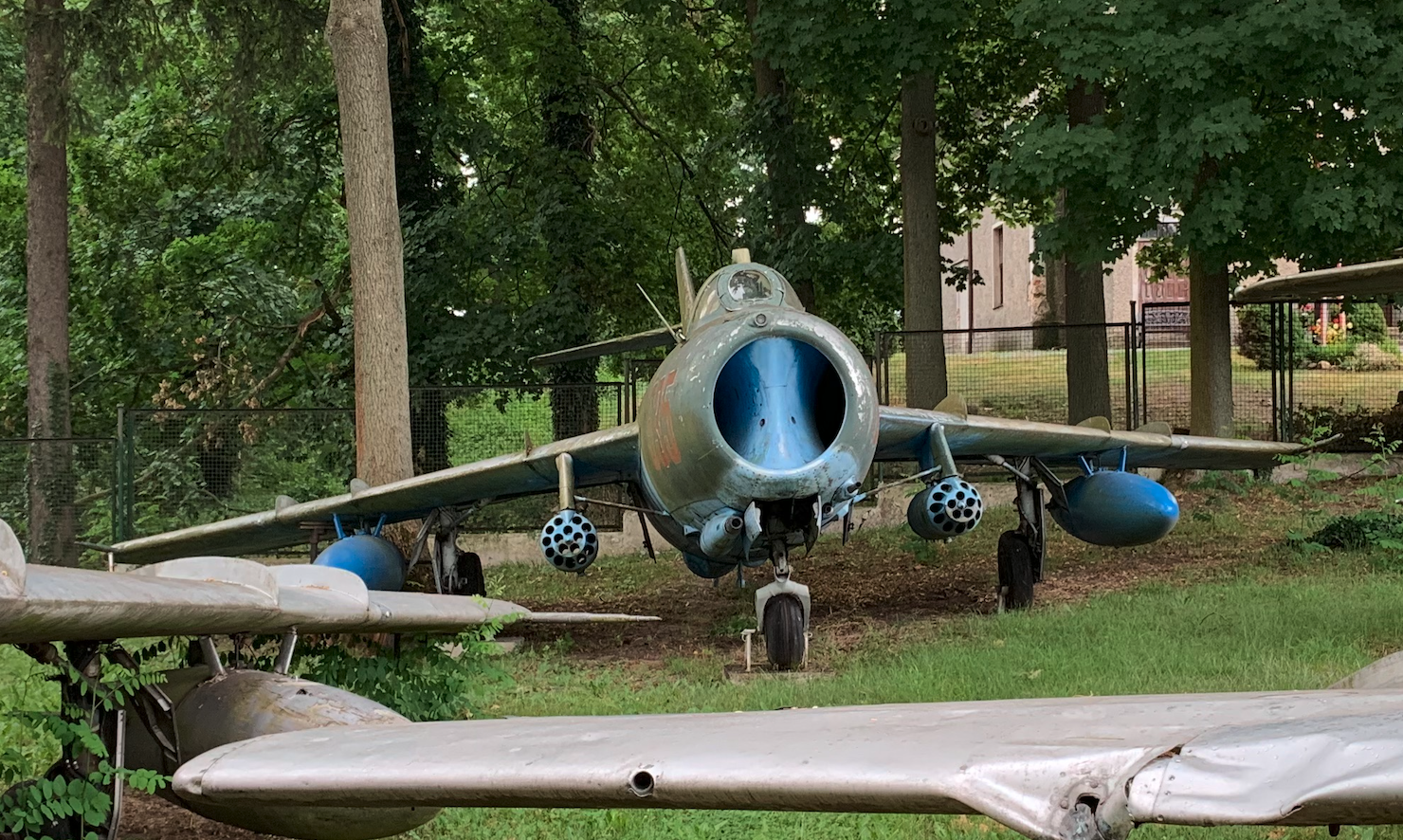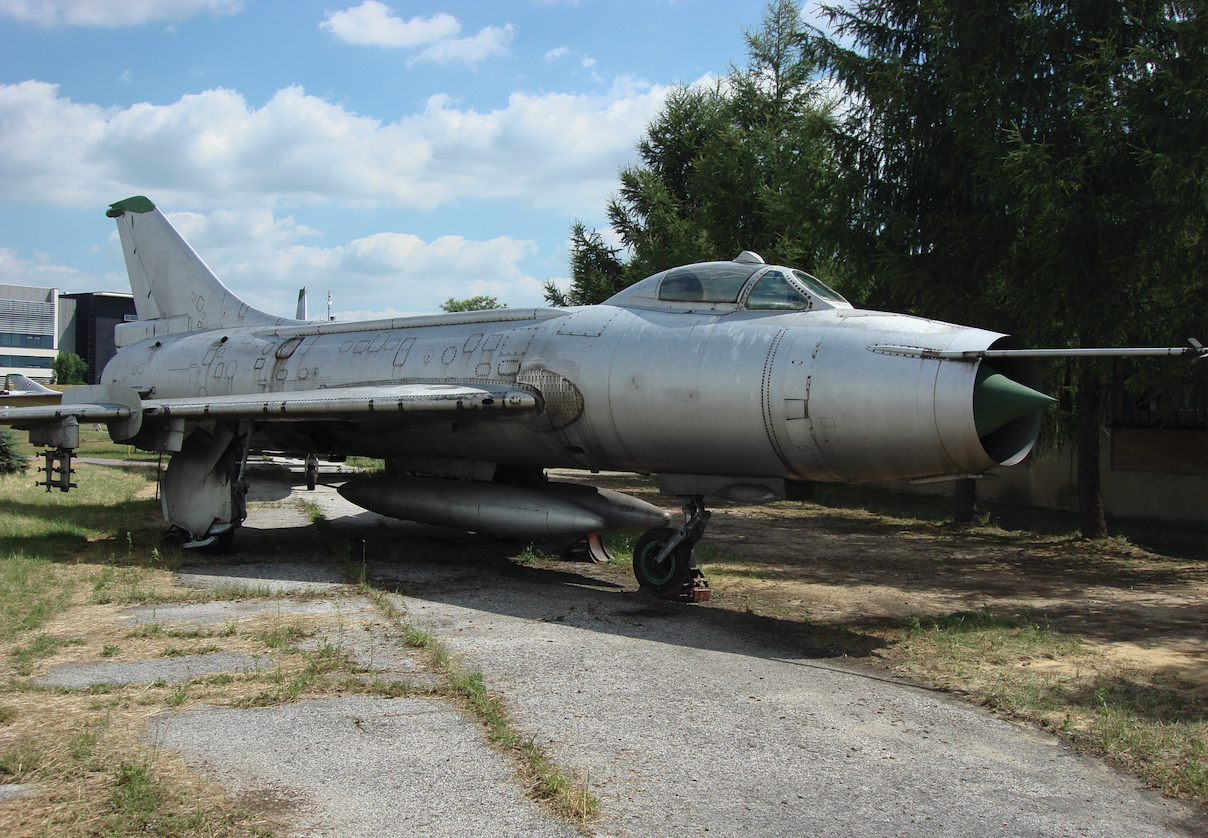Kraków 2014-12-01
The structure of the Polish Army Aviation in the 70s of the 20th century.

In the 70s, MiG-21 MF aircraft were the basic fighters in the Polish Army. The presented aircraft was used in the 10th PLM in Łaski. One of its pilots was Captain Andrzej Śliwiński. After service, the aircraft went to the Polish Aviation Museum in Krakow.
The organization of Military Aviation in every country in the world depends on several factors, three of which come to the fore: 1. Political situation. 2 The amount of funds allocated to the military. 3 Owned equipment, possible upgrades, planned purchases and its replacement.
These three factors determine the structure of the Military Aviation. The 70s of the 20th century were a period of reasonable stabilization in the Polish Military Aviation, without sudden and chaotic changes. This was facilitated by the balance of opposing military blocs. In Poland, after the events on the coast, in December 1970, the leadership of the Polish United Workers' Party was taken over by a new power, and once again the Polish nation believed that socialism could have a human face. Military aviation was stably financed. A satisfactory level of saturation with the technique was obtained. The level of training of professional and conscript soldiers was high, which was facilitated by high morale. There were no acts of desertion among the professional staff. After 12 years of service, a professional officer could go to civilian life. But after 15 years of service, he received the minimum retirement benefit and could take a job in the civilian economy. On the other hand, the Polish Army "saved" many people's lives. It provided relative financial and housing stability. The army was the sector where a professional soldier was provided with a service apartment, where he could stay even after retirement. In society, a professional soldier was perceived as the one who "guards the borders" and deserves respect. Almost all young men were conscripted, so there were few families that had nothing to do with the Polish Army. Due to the obligation to wear formal clothes outside the barracks, soldiers were easily noticed on the street, and the insignia, ribbons, badges and patches belonging to a specific type of armed forces were a source of pride and respect. Among the particularly distinguished services were; sailors, people from Podhale, red berets and, of course, steel uniforms.
Before we move on to the structure of the Military Aviation of the 70-year period, we must also mention that at that time Poland was an occupied country. In our country, an army of many thousands from the Muscovite state was stationed, which even had closed cities in Poland. Their capital was Legnica, commonly referred to by them as Little Moscow.
Structure of the Polish Military Aviation.
Let's look at the structure of the Polish Military Aviation. It was shaped in the period 1967 - 1969 and basically survived (with minor changes) until 1989.
In November 1967, the Air Force Command was established as a result of the merger of Operational Aviation with the Air Force Inspectorate. The seat of the command was in Poznań. As a result, in 1968, the Air Force and the National Air Defense Forces were created. The whole thing was logistically tied together by the Air Force Command (DWL). The difference between one and the other type of troops consisted in the nature of the tasks performed and subordination. The Air Force, previously known as Operational Aviation, in a possible conflict, together with the army of the Moscow state, would move to the West. They were under the command of the Warsaw Pact. On the other hand, the National Air Defense Forces, previously called OPL OK (Country Anti-Aircraft Defence), were intended as a shield to defend the borders and territory of Poland.
Air Force Commanders: Gen. Maj. drink Jan Raczkowski - 1967-1972. Maj. Gen. drink Henryk Michalowski - 1972-1976. Maj. Gen. drink Tadeusz Krepski - 1976-1983. Maj. Gen. drink Tytus Krawczyc - 1983-1989. Maj. Gen. drink Jerzy Gotała - 1989-1990.
Commanders of the National Air Defense Forces: Maj. Gen. drink Roman Paszkowski - 1967-1976. Gen. of arms. drink Longin Lozowicki - 1976-1990.
Air Force - Fighter Aviation.
In 1967, the Fighter Aviation of the Air Force had two Divisions and four Regiments:
5th DLM Świdwin – 4th PLM Goleniów, 40th PLM Świdwin.
9 DLM Malbork – 29. PLM Orneta, 41. PLM Malbork.
These units had fighter aircraft: PZL Lim-2/5 - 60 copies. MiG-21 PF - 22 copies. MiG-21 PFM - 47 copies. Total 129 fighters.
In 1967, the 4th PLM Goleniów changed its name to the 2nd PLM "Kraków" Goleniów. The previous 2nd PLM Czyżyny was disbanded and its planes were transferred to Łask. The 2nd PLM Goleniów, in March 1971, left the structures of the 3rd (later changed to the 5th) Assault/Fighter Aviation Division and came under the command of the 4th DLM.
In 1967, the 4th Pomeranian Fighter Aviation Division was formed. It was created by changing the name of the 9th DLM Malbork. The division existed until 1991. It had in its composition: 41. PLM Malbork and 9. PLM Debrzno (It was a new Military Unit based on the disbanded 11. PLM, in 1968). The 29th PLM Orneta was disbanded on December 31, 1968. No air regiment was based at the Orneta Airport.
In March 1971, the 40th PLM Świdwin was retrained from a hunting regiment and became the Assault Regiment, 40th PLSz. It was the largest transformation of the regiment in the times of People's Poland, related to the complete replacement of aircraft.
Air Force - Fighter-Assault Aviation
In 1967, the air assault had one Division and three Regiments: 16th DLM-Sz Piła: 6th PLM-Sz Piła, 51st PLM-Sz Piła, 53rd PLM-Sz Mirosławiec.
These units had fighter-attack aircraft: PZL Lim-5 - 60 copies, PZL Lim-6 bis - 88 copies. In total there were 148 fighter-attack aircraft.

On June 30, 1967, the 53rd PLM-Sz Mirosławiec received a new name of the 8th PLM-Sz. Even the name 8. Brandenburg PLM-Sz Mirosławiec was temporarily used.
In 1969, the 16th DLM-Sz changed its name to the 5th Brandenburg DLM-Sz. The Division consisted of: 3rd PLM-B Bydgoszcz. 6. PLM-Sz Piła, which was merged with 51. PLM-Sz. 8. PLM-Sz Mirosławiec, previously 53. PLM-Sz. 45. PLM-Sz Babimost.
In November 1969, the 45th PLM Babimost was withdrawn from the structures of the 3rd OPK Corps and transferred to the 2nd DLM-Sz of the Air Force (Operational Aviation) and became the 45th PLM-Sz.
On March 6, 1971, the 3rd Brandenburg Air Assault and Reconnaissance Division Świdwin was formed. The division was created from the transformation of the 5th Brandenburg DLM Świdwin. At the same time, on March 27, 1971, she received under the command of: 8. PLM-Sz Mirosławiec and 32. PLRT Sochaczew.
In 1971, the 8th PLM-Sz Mirosławiec was transformed from Myśliwsko-Szturmowe to Szturmowy, the 8th PLSz and passed under the 3rd Brandenburg DLSz-R Świdwin.
In 1967, the Air Force also had the 8th DLM-Sz Bydgoszcz - 5th PLM-Sz Bydgoszcz, 48th PLM-Sz Inowrocław. However, due to the introduction of Sukhoi Su-7 aircraft into service, changes have occurred. On May 4, 1967, the 5th PLM-Sz Bydgoszcz changed its name to the 3rd Pomorski PLM-B Bydgoszcz. The regiment is directly under the command of the University of Warsaw, but over time it was operationally subordinated to the 16th DLM-Sz Piła. Unit 48. PLM-Sz Inowrocław was disbanded at the end of 1967.
In 1967, the 3rd Regiment of Fighter-Bomber Aviation in Bydgoszcz had fighter-bomber aircraft capable of performing nuclear (atomic) strikes: Su-7 BM - 6 copies, Su-7 BKL - 14 copies. 20 planes in total.

Su-7 delivery schedule: 1964 - 6 Su-7 BM, 1966 - 12 BKL, 1968 - 2 Su-7 BKL, 1969 - 3 Su-7 U, 1971 - 4 Su-7 BKŁ, 1 Su-7 U, 1972 - 12 Su-7 BKL, 1973 - 1 Su-7 U. In the period 1974-1977 - 4 Su-7 U (delivered together with Su-20 to Powidz). In 1986, these planes from Powidz were transferred to the 3rd Aviation Regiment in Bydgoszcz.
Air Force - Aviation (Bombowo)-Reconnaissance.
In 1967, there were three units in the structures: 7. BLR-B Modlin, then Powidz, 21. PLRT Sochaczew, 32. PLRT Sochaczew.
The 32nd PLRT Sochaczew unit had MiG-21 R reconnaissance aircraft in stock.
In 1967, these Regiments had the following aircraft: Bomb equipment: Il-28 - 10 copies. Owned reconnaissance equipment: Ił-28 R - 20 copies, Ił-28 E - 10 copies, Ił-14 E - 1 aircraft, Lim-2 R - 20 copies, Lim-5 R - 15 copies, Lim-2 A - 13 copies copies, SM-1/2 – 20 copies. Total 99 aircraft.
Air Force - other aviation units.
In 1967: 13. PLTr (Regiment of Transport Aviation) Balice. 17th EL (air squadron). 36. SPLTr (Special Transport Aviation Regiment) Okęcie. 56th PŚ (Helicopter Regiment). 49th PŚ (Helicopter Regiment). 47. PLLSAN (Air Regiment of Medical Aviation). 47. SzkPŚ - later transferred to WOSL Dęblin. 10th ELT (tactical air squadron), 11th ELT (tactical air squadron). 26th SELT (independent tactical air squadron).
Air Force - Security units.
in 1967; 6 plat, 7 pzab, 3 pzab, 132 rwrs, 8th mate tech depot, 11th MPS depot, 11th ammunition depot.
In 1972, a new structure of the Air Force was formed; 2. DLSz-R - 6 PLM-Sz Piła, 45 PLM-Sz Babimost, 21 PLRT Sochaczew, 47 ELŁ. 3. DLSz-R – 8 PLSz Mirosławiec, 40 PLSz Świdwin, 32 PLRT Sochaczew, 48 ELŁ. 4. DLM - 2 PLM Goleniów, 9 PLM Debrzno, 41 PLM Malbork, 46 ELŁ. 38. LPSzk-Boj Powidz - since 1974.
Other units of the Air Force.
7 BLR-B Modlin / Powidz. (7 PLB-R Powidz - In 1974, the first Su-20 variable-geometry aircraft were delivered). The Powidz Aviation Training Center was renamed the 38th Aviation Training and Combat Regiment. 3. PLM-B Bydgoszcz, 13. PLT Balice, 36. SPL Okęcie, 37. PŚT Łęczyca, 49. PLWL, 56. PLWL, 17. EL.
National Air Defense Forces.
The OPK troops were divided into three Corps. At the head was the Command of the National Air Defense Forces;
1st Corps OPK - 1 PLM Mińsk Mazowiecki, 10 PLM Łask, 13 PLM Łęczyca, 42 ELŁ-T (liaison and transport aviation squadron), 10 PLM Łask was established in 1968, on the basis of the 31st Air Training and Combat Regiment Łask and PLM 2 Czyżyny . 13 PLM Łęczyca - Disbanded on December 31, 1971.
2nd Corps OPK - 26 PLM Zegrze Pomorskie, 28 PLM Słupsk, 34 PLM Babie Doły, 19 LEH Siemirowice, 43 ELŁ-T (liaison and transport aviation squadron). 34 PLM in 1972, has MiG-21 PFM, M, MF in stock. 28 PLM Słupsk in 1979, the first MiG-23 fighters arrive. The regiment in Słupsk was the only unit equipped with this type in Poland. In 1980, the first MiG-21 bis fighters arrive at 26 PLM Zegrze Pomorskie and 34 PLM Babie Doły.
3rd Corps OPK - 3/11 PLM Strachowice, 39 PLM Mierzęcice, 62 PLM Krzesiny, 44 ELŁ-T (liaison and transport aviation squadron). 11 PLM (3 Corps OPK) Starachowice - At the end of 1967, 11 PLM Strachowice changes its name from 3 PLM Starachowice to 11 Brandenburg PLM Starachowice.
Naval Aviation.
Naval Aviation was treated in two ways. On the one hand, it served as the defense of the coast and the Baltic Sea, being subordinated to the Navy. On the other hand, it operated as part of the National Air Defense Forces. It was headed by the Naval Aviation Command, which, however, did not report to the 34th PLM Babie Doły.
The composition was: 7 PLM-Sz MW Siemirowice - Established in 1967. by changing the name of 30 PLM-Sz to 7 PLM-Sz. 15 SELR MW (Independent Rescue Aviation Squadron). 18 ELŁ MW (Liaison Aviation Squadron). 28 ERat MW (Rescue Squadron).
School and training-combat regiments.
31st Air Training and Combat Regiment Łask - In 1967, it was disbanded. In its place, the 10th PLM Łask was established.
In 1969, WOSL (Higher Officers' Aviation School) Dęblin was composed of: 58. LPSzkB, 60. LPSzk, 61. LPSzkB, 66. LPSzk, 23. LESzk.
In 1972, WOSL (Higher Officers' Aviation School) Dęblin has: 38. LPSzk, 47. SzkPŚ, 58. LPSzkB, 60. LPSzk, 61. LPSzk-B - (Air Training and Combat Regiment) Biała Podlaska - existed in period 1976 - 2000 (JW. 5058). In 2000, transformed into the 3rd Aviation Training Centre. 66. LPSzk, 23. LESzk.
In conclusion, it is worth mentioning that the dislocation of air units in the 1970s was subordinated to possible directions of action. The units were concentrated in the north-western part of Poland. Despite Poland's accession to NATO in 1999, there was no significant change in the dislocation of air units. There was only a reduction. The rulers could not even afford to use the large airport in Biała Podlaska, and they allowed its degradation. The agent activity of some politicians became visible here.
Written by Karol Placha Hetman
